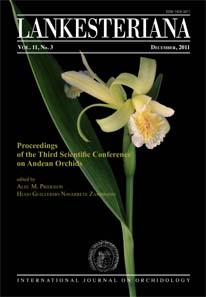The role of common orchids in appreciating the complexity of biodiversity conservation
DOI:
https://doi.org/10.15517/lank.v11i3.18284Keywords:
Orchidaceae, conservation, disturbance, trampling, Cypripedium parviflorum var. pubescens, Epipactis helleborineAbstract
To conserve a species, we must understand its biology, ecology, and relative vulnerability to change. To conserve biodiversity, we need a profound understanding of the relative impact of natural and anthropogenic disturbances and species interactions and of the role of the ecosystem in species survival. Assumptions of the basis for abundance and decline and therefore conservation status might be ill founded if we miss critical aspects of life history or of inter-relationships with other organisms. For more than two decades we have monitored populations of two common terrestrial orchids that grow in close proximity in Gatineau Park, Québec, Canada. The relative abundance and availability of large populations of Cypripedium parviflorum var. pubescens and of the introduced Epipactis helleborine presented us with an opportunity to conduct in situ experimentation, and to develop and evaluate conservation approaches not possible with uncommon or rare orchids. We have learned that the distribution, patchiness, and persistence of E. helleborine is related to the presence and diversity of trees and that seeds of this orchid in trampled soil may germinate better than those in undisturbed soil but that location is a likely overriding variable. Experimental trampling within colonies of common orchids has revealed that the fungivorous nematode community is negatively impacted by foot traffic, which could be reflecting subtle changes in the soil fungal assemblage upon which the nematodes feed. While mature plants of C. parviflorum var. pubescens do not seem to have been affected by nearby foot traffic, seed germination and seedling survival could have been altered, but we may not become aware of such changes for some time.
Downloads
Downloads
Published
How to Cite
Issue
Section
License
According to the Open Access policy promoted by the University of Costa Rica, all the papers published by Lankesteriana are licensed under the Creative Commons copyright and can be downloaded free of charge. The journal holds copyright and publishing rights under the CC BY-NC-ND 3.0 CR license.
Before the publication of the materials submitted by the author(s) in LANKESTERIANA, the author(s) hereby assign all rights in the article to the Lankester Botanical Garden.





